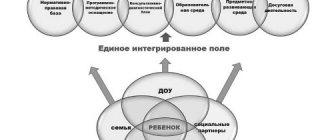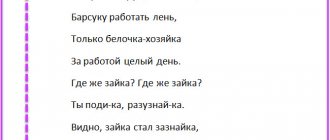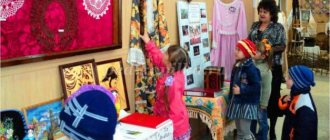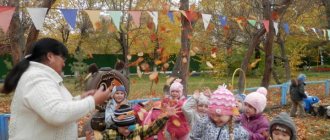Forms and methods of developing children’s ethnocultural awareness
Preschool childhood is an important stage in the development of a person’s moral character. During these years, children lay the foundations of morality and form initial ethical ideas.
The preschooler intensively enters the social world, sensitive and inquisitive. Of great importance in the socialization of a preschooler is the cultivation of respect for the fundamentals of the culture of other peoples, in other words, ethnocultural awareness, or recognition of the diversity of the cultural heritage of other peoples as the norm.
I believe that the success of developing ethnocultural awareness depends on the forms and methods of training and education.
These forms include the following:
1. Cycles of integrated classes, including various types of activities: educational, artistic, visual, musical, gaming based on a single content. In accordance with the topic of the lesson, I determine the dominant type of activity: in one case it can be constructive activity, in another - musical, in the third - cognitive.
At the same time, there are topics where different types of activities are equivalent! For example, in a lesson on speech development on the topic “Holidays of the Peoples of the World,” children will learn what holidays different nations have and how they celebrate them. During the drawing and design class, holiday attributes are made and decorated. In music, they learn songs and round dance games. At physical education classes, they get acquainted with the outdoor games of different nations, and as a result, everything is included in the fun with the children.
2. I conduct cognitive, ethical, heuristic conversations in classes and in my free time, for example, during the morning reception of children or walks, based on:
- children's knowledge about life in the family, because each family has its own national way of life;
- observations, during excursions and leisure activities, which help to acquire knowledge in the field of culture of different peoples and interethnic communication.
3. I use video viewings in classes and in my free time in the afternoon. Video materials include specially created educational programs or recordings of popular television programs on relevant topics. Video viewings allow, firstly, children to create dynamic visual images of the life and activities of different peoples; secondly, to broaden their horizons - preschoolers gain ideas about those events, phenomena, objects that they cannot directly perceive: about historical facts, about the life and architecture of peoples living in different parts of the Earth, about the work of adults in their native land, etc.
4. Entertainment and holidays with ethnocultural and state themes give children a colossal emotional charge and sharpen observation and perception, enrich sensory experience, and therefore form a genuine interest in ethnocultural phenomena. Every year we spend with children: among the Russian people: Christmas, Maslenitsa, Easter; among the Tatar people: Navruz, Kurban Bayram, Sabantuy.
5. Folklore concerts and theatrical performances are organized with the participation of teachers, children and their parents, providing an opportunity to plunge into another ethnoculture, to be in the image of a representative of another nationality. Concerts in which songs, dances, and playing musical instruments can be dedicated to one topic (for example, celebrating calendar holidays), or can be combined (held at the end of the school year as a final concert). In turn, the scripts for theatrical performances are based on folk tales or original stories that reflect ethnocultural specifics. They can reproduce calendar and family holidays with accompanying folklore rituals, reflect certain ethnographic realities (for example, staging gatherings, receiving guests, work activities, etc.).
6. Targeted walks and excursions ensure that children get to know the social, cultural and natural diversity of their native land; we visit: libraries, a puppet theater, an art gallery, a museum, monuments, parks. The objectives of this type of activity are to activate existing knowledge, enrich experience, and help the child acquire objective ideas and knowledge about ethnic communities and their culture outside of class.
On walks, I invite children to check folk signs, guess a riddle, find confirmation of a saying, and focus on the features of the landscape, climate, and natural phenomena inherent in Tatarstan and its geographic latitude. This will allow children to get live impressions and acquire fairly generalized knowledge of local history.
Excursions, visits to exhibitions, museums and other cultural sites contribute not only to expanding knowledge about the local environment, but also to acquiring new information about the realities of other ethnic worlds and natural environments, about the peculiarities of the way of life and culture of other peoples.
Let us now dwell on the methods and techniques of intensifying the process of forming ethnocultural awareness of children:
1. Game methods and techniques arouse increased interest and positive emotions in children, promote concentration on the educational task, which becomes not imposed, but its own personal goal. Using various didactic, role-playing, active, and constructive games, we organically and purposefully introduce children to the world of folk culture and the ethics of human relations. Such games include: folk active and comic games with peers and adults, folk jokes and counting rhymes.
For example, to identify the level of awareness of children, we use games like “Edible - inedible”, “Antique - non-antique” (used in the past and in the present tense: bast shoes - shoes, braid - shirt, washboard - car, etc.) These games can be carried out as sedentary games (the teacher names the word, and the children, depending on what culture, what period of time, etc. it can be attributed to, crouch or clap their hands, catch or throw the ball) or as didactic games (by such as “Wonderful bag”, “Find the mistake”, “Select what you need”, etc.).
2. The method of imaginary situations (place, roles, equipment, actions) increases the degree of assimilation of cognitive material.
For example, I suggest imagining that children are in the forest, on a desert island, some kind of republic, etc.; imitate substitute things; They flew like birds, galloped like horsemen.
3. The game-travel method is used to clarify children's knowledge.
4. The surprise moment method helps to activate the emotionality of children. For example, a parcel arrived with gifts, performing various game actions (for example, playing a folk outdoor game), playing roles (the teacher appears in the image of the mistress of a Russian hut or in the image of a representative of another nationality), etc.
5. Verbal method.
- A valuable technique is comparison, which allows us to identify the general and special in the historical development and cultures of different peoples of the world, the reasons for these similarities and differences. So, children can be offered grouping and classification tasks. “Arrange the pictures into two groups: in one - everything that can be attributed to Russian culture (things, household items and art, culinary dishes, fairy-tale characters and other symbols), and in the other - everything related to Tatar culture.”
- Reception developmental questions. During such a conversation, I pose questions, encourage children - on the basis of observations, personal experience, ideas, previously acquired knowledge - to compare, contrast individual facts, phenomena inherent in ethnic cultures, and then, through reasoning, draw conclusions, highlighting something common, special or unique in the cultures of different peoples.
6. Modeling and design method combining verbal explanation, practical implementation and game motivation. This method is indispensable when working with the globe, with diagrams and maps. In addition, each child has a notebook-album in which, with the help of signs, symbols, drawings, he reflects everything that he learned in class, excursion and what he liked.
7. The project method involves organizing joint research activities of children and their parents in collecting, studying, analyzing, and then presenting materials that reveal the characteristics of traditions, lifestyles, household items, and art of different peoples.
Research topics are proposed by teachers in accordance with the thematic plan, or chosen independently by family members. Here are the topics of some research projects: “The image of Baba Yaga in Slavic fairy tales,” “The purpose of a towel in peasant life,” “Tea drinking ceremony,” “Genealogy of my family,” etc. All of the above methods are used by teachers in different organizational forms and types of activities.
The art of teachers lies in the skillful combination of methods and techniques, in their logical correlation with the form, place of use, age and individual characteristics of the pupils.
When introducing children to national heritage, parents play a huge role. It is in the family that children receive their first ideas about the culture of their people, and respect for representatives of other cultures and for these cultures themselves is formed.
Using the family's potential is carried out by:
- involving parents in conducting classes (introducing children to the customs of the peoples of which they themselves are representatives, or teaching them some craft or skill with ethnocultural specifics: embroidery, wicker weaving, wood burning, playing a folk musical instrument);
- participation of parents in exhibitions of family creativity;
- arranging presentations of national rarities and family traditions;
- provision by parents of photographs, albums, brochures, video materials of household items and art kept by the family or brought from travel.
- creating a mini-museum of family collections in a group room;
- parents conducting walks and excursions along routes proposed by the teacher;
- joint participation with children in a folklore concert, performance or entertainment with ethnocultural themes;
- conducting research activities with children (project method) with further presentation of its results in the educational process.
During the work, we introduced the children to their hometown and the peoples living in it; geographical location, history and folk applied art of the peoples of the Volga region.
As a result of this work, the children learned to love their city, their native nature, and treat it with care. Communication with nature and the origins of the culture of the peoples of the Volga region ennobles a person and allows him to more fully experience the beauty of life. Children became observant, inquisitive, their speech was enriched, their horizons expanded, and their relationships with their parents became closer.
In the future, we plan to continue the work we have begun in ethnocultural awareness of children.
Ethnocultural component in the educational process of a preschool educational institution
Everyone says Motherland. But what do we mean by this word? Where did you grow up? Or where were you born? No, the homeland is not determined by the place of residence and birth. The real Motherland is a place where a person always strives to return, it is a place where a person feels part of this place. The homeland is a piece of the world that we try to preserve, preserve, and protect. This is a place where we are welcome, where we feel good and free.
My native land is songs, games, holidays, ditties, books, language, culture and history, these are the first memories from childhood, this is picturesque Bashkir nature, bright sun, endless blue sky and endlessly beautiful forests. There are many beautiful places in the world, but the most dear and beautiful place for me is my native land. Every person must love and protect his homeland.
We are often not inclined to get acquainted with the past of our native land, its history, past, culture, culture of relationships. As you know, by appreciating and knowing the past of your native land and taking care of the present, you can create the future.
An educated person is interested in history and cultural tradition. He has formed cultural needs: meaningful activity, higher spiritual principles, the desire for morality. He feels belonging to a certain culture and ethnic group.
The study of ethnocultural phenomena is a necessary condition that contributes to the development of ethnocultural education. A large role for the development of ethnocultural education is assigned to educational institutions. Since the most important transmitter of national and world culture are preschool educational institutions.
The need to organize the educational process in preschool educational institutions on an ethnocultural basis was recognized by domestic teachers from the very beginning of their creation in Russia. Ethnocultural historical experience should determine the uniqueness of educational work in preschool educational institutions.
Ethnocultural education is a system in which all goals, technologies and content are aimed at the development and socialization of the child’s personality as a subject of an ethnic group and as a citizen of the multinational Russian state. Ethnocultural education implies the introduction into the educational process of knowledge of native folk culture, the cultivation of friendly attitudes towards people of different nationalities, spiritual and moral values, the history of folk culture, social norms of behavior, familiarization with the cultural achievements of other peoples, the use of the experience of folk education in order to develop children's interest in native culture.
Currently, we have a new attitude towards traditions, holidays, arts and crafts, decorative and applied arts, which we inherited from our ancestors. Therefore, it is important for us to introduce preschool children to the origins of national cultures.
In preschool educational institutions, children are introduced to the history, nature of their native land, culture, acquaintance with their native land, with the past of their native land.
The ethnocultural component permeates life in kindergarten. Accompanies children from the nursery group to the preparatory group. In the form of fairy tales, proverbs, fables and folk games. Children's horizons expand through rituals, holidays and customs.
As a result of this work, children develop their personality, worldview, attitude, moral, social and aesthetic development.
This interesting, rich, alluring and vibrant life will not leave children indifferent.
The ethnocultural component is the path to a national culture. This is a means of reviving beauty, independence, individuality, cognitive activity, and familiarization with the identity of the people.
With the help of ethnocultural education, children develop friendliness, goodwill, and a sense of empathy.
Ethnocultural education is a process in which the goals, objectives, content, and technologies of education are aimed at developing the individual as a subject of an ethnic group and as a citizen of the multinational Russian state.
Ethnocultural education is introduced by introducing knowledge of spiritual and moral values into the educational process, fostering friendly attitudes towards people of different nationalities and cultures, social norms of behavior, knowledge of native folk culture, familiarization with the culture of other peoples, and developing children’s interest in folk culture.
Children attending a preschool educational institution with an ethnocultural component develop more developed cooperation skills and a value-based attitude towards the cultural and historical characteristics of their native land, the formation of professional interest and the desire to further realize themselves in the field of creative, stage or vocal direction; artistic and aesthetic taste develops. Children also have a higher level of cognitive development, learning ability, emotional and aesthetic. This is due to the fact that a preschool educational institution with an ethnocultural component pays great attention to emotional, aesthetic and cognitive development. The groups maintain a favorable environment for the development of the child’s personality; children get acquainted with nature, environmental relationships, cultural and historical knowledge, and works of art. In kindergarten, thanks to the ethnocultural component, a favorable background, which is so necessary for the development of the child’s personality, children are introduced to sculptural knowledge - historical knowledge, folk crafts, works of art, Russian nature, environmental relationships, monuments of literature, fine and musical art. The process of using the means of the ethnocultural component is more effective: theatrical performances, folk games and holidays, ensemble, reading fiction.
Quite high rates of speech development and play in children attending preschool educational institutions with an ethnocultural component of education. This is due to the fact that the speech activity of such children is higher, due to the fact that children often participate in folk games and holidays, in theatrical performances, and in artistic productions.
Principles for introducing an ethnocultural component into the education of preschool children:
- Reliability - ethnocultural information must be reliable;
- Entertaining - the inclusion of an ethnocultural component should evoke interest and an emotional response, satisfying the need to know oneself and the world around us;
- Accessibility - information must be accessible to children of a certain age and have a clear logic of presentation;
- Variability - the information presented must allow for variability of points of view, based on arguments, evidence, and include anti-stereotypical elements;
- Complexity - educational material is presented by different means: demonstrations, verbal story, conversation, visual illustrations, practical experiments, organization of observation, research activities, demonstration of a method of action. As a result, children can receive information at the auditory, visual and muscular levels of perception;
- Polyartism - involves the child’s participation in various types of creative activities and learning many types of crafts;
- Egocentricity - the information provided must affect the interests of the child, satisfy his needs in the ethnocultural sphere, be significant for him, contribute to his self-development, self-awareness and self-improvement;
- The principle of continuity and consistency in the study of cultures. It is important to understand that children cannot fully understand all the many ethnic cultures of Russia and the world. First of all, children should have a good knowledge of the culture of their people and region.
The ethnocultural component increases the effectiveness of the educational process of a preschool institution.
From pedagogical experience it is known that an important component for creating high opportunities for education in the conditions of the ethnocultural component is the interrelation and unity of public and family education.
Successful and high performance of the educational process depends on the cooperation between children, teachers and parents. To successfully form cooperation, it is important to imagine the team as a big close-knit family. It is also necessary to organize joint activities.
This contributes to the establishment of mutual understanding between teachers, children and parents, unity, and the creation of a favorable climate in the family and in the educational preschool institution.
Accordingly, it is reasonable to organize a joint part of the work with children and parents, solving assigned tasks and problems together. Join efforts to achieve high results without infringing on each other's interests.
A partnership between parents and teachers makes it possible to better choose an approach to a child, look at him from different angles, establish contact in different situations, and consequently help parents understand the individual characteristics of the child, as well as successfully overcome possible difficulties in upbringing.
Means of ethnocultural education and upbringing of preschool children
Natalia Beskrovnaya
Means of ethnocultural education and upbringing of preschool children
Historically, the problems of ethnocultural (national)
upbringing and education of children arise in our country when the systems of government are being reformed and the time comes for corresponding changes in the field of education .
Modern Russia is experiencing a crisis in educating the younger generation. Traditions were broken, the threads that connected the younger and older generations were broken. The merciless cutting off of one's roots, the rejection of nationality in the educational process leads to the loss of value guidelines and the lack of spirituality of society. Raising children in the spirit and on the material of traditional national culture, restoring the system of continuity of folk traditions is one of the ways to overcome crisis situations.
Ethnocultural education is a process in which the goals, objectives, content, and technologies of education are focused on the development and socialization of the individual as a subject of an ethnic group and as a citizen of the multinational Russian state.
The purpose of ethnocultural education in preschool age is :
- introducing children to the culture of their people;
— development of national identity;
— fostering a friendly attitude towards representatives of different ethnic groups;
— development of sustainable interest in learning and accepting other cultural national values.
Ethnocultural competence is not just an idea of the history and culture of other nations and nationalities, it is recognition of ethnocultural diversity . Preschool age is characterized by intensive entry into the social world, the formation in children of initial ideas about themselves and society, sensitivity and curiosity. Therefore, this period is very favorable for the formation of ethnocultural awareness .
Therefore, the main components of the formation of ethnocultural competence are the creation of conditions for:
— holistic development of the child’s personality through his introduction to traditional folk culture;
— education and respect for the culture of interethnic communication, tolerance, the ability to interact with the outside world, as well as the creation of pedagogical conditions for the formation of ethnocultural competencies in preschool .
One of the important pedagogical aspects of the formation of ethnocultural competence of preschoolers is the active involvement of parents in this activity.
The purpose of such interaction with families is to involve parents in the ethnocultural educational process , including the physical, emotional, spiritual and moral education of children based on the traditions of folk culture. When forming the ethnocultural competence of preschoolers , we must focus on introducing them to beauty and goodness, on the desire to see the uniqueness of their native culture and nature, and to participate in their preservation and enhancement. After all, how our children, the people of the new generation, will grow up – everything depends on us.
From early childhood, a child needs images , sounds, colors. All this is contained in abundance in folk art and the life of the Russian people. Fairy tales, riddles, sayings, proverbs represent a real treasury of folk wisdom. Songs, music, and dances convey the harmony of sounds, melody, and rhythm of movements, which express the character traits of the people.
By joining the folk art of different ethnic groups, preschool children not only learn the history, traditions, and culture of peoples, but this activity contributes to the successful development of preschool children’s basic psychological processes (memory, attention, thinking, emotions, communication skills, cognitive activity).
Russian folk art: fairy tales, games, songs formed the basis of the preschool education of our kindergarten and our group. Much attention is paid to the following types of work:
- study of fairy tales, sayings, nursery rhymes, proverbs;
— acquaintance with Russian folk toys and games;
— creation of a “Russian hut”
(museum mini-games in kindergarten)
.
The first thing we begin to introduce the kids to is, of course, Russian folk nursery rhymes, pestushki, songs, which we use during routine moments, washing, getting dressed for a walk, waking up, having lunch: “Okay, okay”
,
“Stretch - stretch”
,
“Cooked porridge”
.
The Russian people call proverbs and sayings winged words, and the peoples of the East call them a pearl strung on a string. Various folk sayings and proverbs are often used both in specially organized activities and throughout the day. At the same time , attention is drawn to the fact that each nation has its own proverbs and sayings, let’s say about work, but they are very similar in meaning. Among the Tatars: “You can’t catch a hare without work”
,
“Talk less - do more”
among the Russians -
“Without labor you can’t take a fish out of the pond”
,
“It’s time for business - time for fun
.
In younger groups, children are introduced to folk toys (pyramid, matryoshka, gurneys, rocking chairs, fun toys, etc.)
. From age to age, the tasks of expressiveness in conveying game actions in combination with words, methods of indicative actions in wise folk toys become more complicated - they require not only curiosity, but also ingenuity.
At the same age, children become involved in games. Games foster a sense of brotherly communication and camaraderie.
At the same time, this is a competition in strength, dexterity, and ingenuity.
Games develop initiative, organizational skills, and resourcefulness. Many ancient games included singing. This decorated them, contributed to quick memorization, and gave them rhythmic coherence.
Folk holidays are traditionally held in kindergarten: Carols, Maslenitsa and others. Children get acquainted with Christian holidays: Christmas and Easter.
preschool children not only to see and understand an object, but to see it in action. It's even better to take part in this action. “Russian Izba” created in the kindergarten
Traditional national costumes of the peoples of the Volga region and household items were demonstrated; children had the opportunity to come into contact with ancient utensils, examine embroidered clothes, and jewelry.
The teacher gives the concepts of ancient folk words that are not used in the modern language, explaining their meaning (cast iron, grip, spinning wheel, kerosene lamp, torch, etc.)
In the
“Russian Izba”
, children begin to learn the history of their people.
An ancient wisdom reminds us: “A man who does not know his past knows nothing.”
.
It is necessary to convey to the consciousness of children that they are carriers of folk culture, to raise children in national traditions. After all, raising children in national traditions has a positive effect on the spiritual and aesthetic development of children.
The productive use of progressive experience in ethnocultural education of children involves not simply borrowing ideas and practical developments, but their further development in the context of modern educational : humanization, activity of the learning process, spiritual, moral and personal development, development of patriotic feelings, nurturing a culture of interethnic communication.







